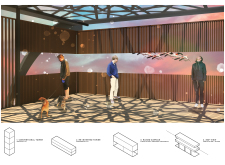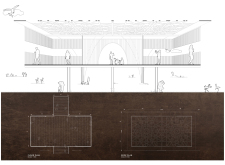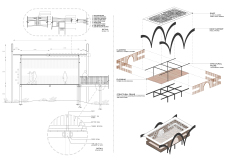5 key facts about this project
At its core, The Looking Post represents a thoughtful interaction between architecture and environment. It is designed to blend seamlessly into the landscape, using materials and forms that reflect the characteristics of the surrounding habitat. This is achieved through a combination of horizontal expansiveness and lightweight structural elements that lend the building a delicate presence. Rather than constructing a typical observation tower that disrupts the natural sightlines, the project embraces a more fluid silhouette, drawing inspiration from the graceful movements of the flamingos themselves.
Functionally, The Looking Post provides a platform for various recreational and educational activities. Visitors can engage in birdwatching, photography, and ecological education, all while enjoying panoramic views of the wetlands. The design incorporates multiple lookout points that facilitate a 360-degree experience of the natural vistas, enhanced by open floor plans that enable flexibility for different group sizes and interactions.
The architectural details of The Looking Post are meticulously considered to enhance both its aesthetic appeal and practicality. The structure is elevated on slender steel columns, which minimizes its footprint and ensures minimal disruption to the delicate wetland ecosystem below. This approach is significant, as it not only reduces the environmental impact but also allows visitors to feel a sense of immersion in nature, almost floating above the foliage.
Material selection plays a crucial role in the project’s success. The use of lightweight steel for the frame ensures structural integrity while maintaining a minimalist presence. Timber decking creates warmth underfoot, inviting users to walk and linger, and vertical timber louvers serve dual purposes: providing shade and facilitating airflow while allowing for glimpses of the surroundings. The glass-cladded roof structure enables natural light to flood the interior, enhancing the user experience and mirroring the patterns of light and shadow that characterize the wetland landscape.
Unique design approaches are present throughout the project. The interplay of solid and transparent materials generates a harmonious balance. The vertical timber louvers not only act as a functional element for providing shade but also create a visual filter, presenting the views outside in a manner that encourages contemplation and connection with the environment. This design ethos prioritizes sustainability and respect for nature, incorporating educational elements that inform visitors about the local wildlife and the importance of conservation efforts.
Overall, The Looking Post is a representation of contemporary architecture that respects and responds to its natural context. Its thoughtful design creates opportunities for education and interaction while preserving the integrity of the wetlands. For those interested in a deeper exploration of this project, reviewing the architectural plans, sections, and various design elements can provide further insights into how this unique structure was conceived and executed. Readers are encouraged to delve into these aspects to appreciate the nuances of the architecture and design choices that have shaped The Looking Post.


























